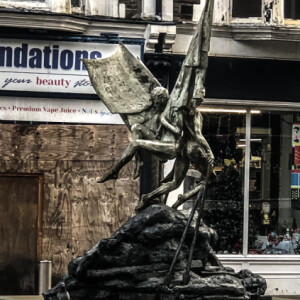Charterist statues
Sculpture group illustrating the desire for political change, and how this desire motivated the Chartist movement. The three groups take their titles from the motto of the Chartist convention: 'Union, Prudence, Energy':
Union (The Ideal City) - a man and a woman carry a model of Newport surrounded by dancing children. The group refers to the physical appearance of Newport: "The children dance through the space underneath the model, which is a reminder of the many tunnels and fly-overs that weave their way in, around, under and through the land on which Newport is built."
Prudence (Still Life). Two figures representing the arts, commerce and industry which have played an important part in the fortunes of Newport both in the past and present.
Energy (Apotheosis). Three recumbent figures arranged in strata like the soil, they lie seemingly crushed but they form the foundation from which the spirit of Chartism, represented by the flying figures, sprang.
Chartism was a working class movement for political reform in Britain between 1838 and 1848. The six main aims of the movement were in the People's Charter of 1838:
A vote for every man twenty-one years of age, of sound mind, and not undergoing punishment for crime.
The secret ballot. - To protect the elector in the exercise of his vote.
No property qualification for members of Parliament - thus enabling the constituencies to return the man of their choice, be he rich or poor.
Payment of members, thus enabling an honest tradesman, working man, or other person, to serve a constituency, when taken from his business to attend to the interests of the Country.
Equal Constituencies, securing the same amount of representation for the same number of electors, instead of allowing small constituencies to swamp the votes of large ones.
Annual parliaments, thus presenting the most effectual check to bribery and intimidation, since though a constituency might be bought once in seven years (even with the ballot), no purse could buy a constituency (under a system of universal suffrage) in each ensuing twelve-month; and since members, when elected for a year only, would not be able to defy and betray their constituents as now.
When their petition was refused, many advocated the widespread use of force as the only means of attaining their aims. One of the actions was the Newport Rising on 4 November 1839, when somewhere between 1,000 and 5,000 Chartist sympathisers, including many coal-miners, most with home-made arms, led by John Frost, marched on the town of Newport intent on liberating fellow Chartists who were reported to have been taken prisoner in the town's Westgate Hotel.


Comments
Sign in or get an account to comment.


